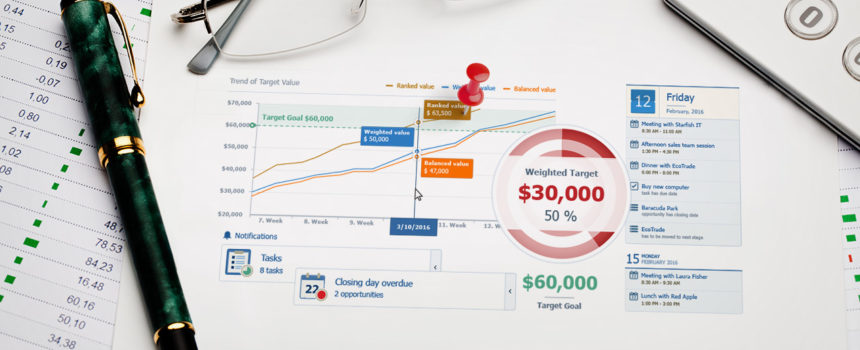In our continuing series on the pain points of sales management, we have explored the categories of sales management, the primary pain point of sales management, the technology a sales manager really needs, the vital subject of management, and specific pain points of sales management at a new company (part 1 and part 2).
Now let’s take up a very crucial subject for sales managers: sales forecasting.
Forecasting means accurately predicting the amount of sales that will be closed during a particular sales period—month, quarter, half-year or year.
An accurate sales forecast is a prime factor for a number of important activities. For example, every publicly traded company today must accurately predict its revenue, such prediction being based on an accurate sales forecast. When a company falls 2-3% short of predicted revenue, analysts and other financial critics generally take it to task. So before a company reaches that level, they should have sales forecasting well in hand.
Inside the company, a sales manager’s job can be made or broken by forecasting. Regularly inaccurate forecasts means reduced confidence in that sales manager. Of course, the opposite is also true–regularly accurate forecasts will mean increasing confidence in that manager.
“The trick to forecasting would be to have enough deals in the pipeline to determine the number you will end at. Ideally, you have x times the target value in pipeline you need based on win rates to see if you can hit your target. For example, if we close 1 out of 3 deals, we need 3x the target in the pipeline. If you don’t have enough in the pipeline, then you have to review the possibility of each single deal closing. At that point, the weighted, balanced and ranking views come in very handy. You also then need to review deals scheduled to close next month or beyond and pull those in early.
“Forecasting is also a challenge because you are trying to guess where you will end up at the end of the month in the beginning of the month when things are the most unclear. Deals also tend to close right at the very end which is the most risky.”
-L.F., Sales Manager, Pipeliner CRM user
Accurate Sales Forecasting
The 2 primary components to sales forecasting are people, and technology. Most people understand that you cannot perform accurate forecasting without technology. But it also requires a thorough understanding of of the people in your sales team, who can fall anywhere within the gamut of sales forecasting:
- Underestimating, because they’re scared to really put their necks on the line and know that if they underestimate and come in over their estimation, they’ll be heroes.
- Correctly estimating,
- Overconfident, which is where you find most salespeople. They’re basically telling you what they know you want to hear, but rarely meeting their own predictions
If people and technology are the raw materials of forecasting, how do you bring them together?
Let’s say your sales rep Arnold informs you that his sales forecast is $50k for this month. That sounds great–but then it falls to you to perform a reality check on Arnold’s forecast. With Pipeliner CRM it’s simple: A couple of clicks, and you can visually look over Arnold’s pipeline and see if his open opportunities add up to 50k, and how likely they are to close.
Accurate Forecasting Creates Tasks
It’s almost a natural law that when a forecast is accurate, you’ll immediately see activities occurring to bring it about. Real opportunities create activities.
An inaccurate forecast, on the other hand, will bring about a very obvious lack of tasks and activities. In fact, there is often a mad rush to create the missing leads and opportunities needed to meet that forecast.
Technology and Accurate Sales Forecasts
On the technology side, the more simple and intelligent the approach, the more effective the forecasting. Unfortunately, most CRM systems fail in this regard. Pipeliner, however, utilizes the science of cybernetics—the science used to simplify complexity—and for that reason is able to provide highly effective forecasting facilities.
With Pipeliner, you can bring in factors in addition to the sales figures, such as commissions. This makes Pipeliner’s forecast functionality valuable to reps themselves—they can forecast their actual commissions for a sales period.
Learning from the Past
A prime factor in accurate forecasting is the review of past performance. With Pipeliner, you can review a previous sales period and isolate the sales that fell into new business, renewals, and upsells. You can see the amount of sales per rep. In short, you can actually see what happened.
You can also compare a rep’s forecasted figures against what they actually closed for a particular period, so you can see how they generally forecast (over, under, or pretty close to accurate).
Evaluating Your Sales Process
Forecasting is also a great aid for sales process evaluation. If you have outmoded or unused sales process steps, if opportunities are delayed in your process because the correct tasks or actions are missing, your forecast will be negatively impacted. You can then correct the process.
Much More
There is much more to know about sales forecasting—but these are the essentials. Learn them, and you’re well on your way!
Forecasting is a prime benefit of Pipeliner CRM. Try it today.





















